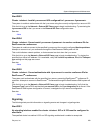
System Management and Maintenance
Polycom, Inc. 351
If this alert reoccurs frequently but quickly goes away, that suggests intermittent spurious network problems.
If it persists for more than about 15-30 seconds, it may indicate serious network problems. It’s also possible
that someone shut the cluster down or that it failed.
Click the link to go to the Territories page. To enable conferencing to continue in the territory (at diminished
capacity), assign it to some other cluster.
We recommend assigning a backup cluster for each territory.
See also:
Alerts
Alert 1107
<alerting-cluster>: Primary cluster <p-cluster> associated with territory <territory> is not
reachable. But backup cluster <b-cluster> is reachable.
The cluster from which the alert originated is unable to communicate with the specified territory’s primary
cluster, but can communicate with the backup cluster.
This may be a temporary problem, in which case this alert will be cleared as soon as the alerting cluster is
once again able to communicate with the cluster in question.
If this alert reoccurs frequently but quickly goes away, that suggests intermittent network problems. If it
persists, it will be followed by Alert 1108, indicating that the territory has failed over to the backup cluster.
The backup cluster allows conferencing to continue in the territory (at diminished capacity) and fulfills any
other responsibilities assigned to the territory.
Click the link to go to the Territories page. Determine whether the cluster was deliberately shut down. If not,
try pinging the cluster’s IP addresses.
If this is a two-server cluster, and you can’t ping either the virtual or physical IP addresses, look for a network
problem. It’s unlikely that both servers have failed simultaneously.
If you can ping the cluster, the OS is running, but the application may be in a bad state. Try rebooting the
server(s).
See also:
Alerts
Alert 1108
<alerting-cluster>: Territory <territory> has failed over from <p-cluster> to <b-cluster>.
The territory’s primary cluster is unreachable, and its backup cluster has taken over.
This may indicate a network problem. It’s also possible that someone shut the cluster down or that it failed.
The backup cluster allows conferencing to continue in the territory (at diminished capacity) and fulfills any
other responsibilities assigned to the territory.
Click the link to go to the Territories page. Determine whether the cluster was deliberately shut down. If not,
try pinging the cluster’s IP addresses.
If this is a two-server cluster, and you can’t ping either the virtual or physical IP addresses, look for a network
problem. It’s unlikely that both servers have failed simultaneously.


















